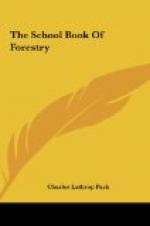Experience has proved that correct systems of handling the private forests can not be secured by mere suggestions or education. No ordinary method of public cooeperation has been worked out which produces the desired results. It is necessary that suitable measures be adopted to induce private owners to preserve and protect their woodlands. The timberlands must be protected against forest fires. Timber must be cut so as to aid natural reproduction of forest. Cut-over lands must be reforested. If such methods were practiced, and national, state and municipal forests were established and extended, our lumber problem would largely solve itself. We not only should produce a large permanent supply of timber for domestic use, but also should have great reserves available for export. Under such conditions, the United States would become the greatest supply source in the world for lumber.
CHAPTER XV
WHY THE LUMBERMAN SHOULD PRACTICE FORESTRY
The lumber industry of this country can aid reforestation by practicing better methods. It can harvest its annual crop of timber without injuring the future production of the forests. It can limit forest fires by leaving the woods in a safe condition after it has removed the timber. Some private timber owners who make a living out of cutting lumber, have even reached the stage where they are planting trees. They are coming to appreciate the need for replacing trees that they cut down, in order that new growth may develop to furnish future timber crops.
The trouble in this country has been that the lumbermen have harvested the crop of the forests in the shortest possible time instead of spreading out the work over a long period. Most of our privately owned forests have been temporarily ruined by practices of this sort. The aim of the ordinary lumberman is to fell the trees and reduce them to lumber with the least labor possible. He does not exercise special care as to how the tree is cut down. He pays little attention to the protection of young trees and new growth. He cuts the tree to fall in the direction that best serves his purpose, no matter whether this means that the forest giant will crush and seriously cripple many young trees. He wastes large parts of the trunk in cutting. He leaves the tops and chips and branches scattered over the ground to dry out. They develop into a fire trap.
As generally followed, the ordinary method of lumbering is destructive of the forests. It ravages the future production of the timberlands. It pays no heed to the young growth of the forest. It does not provide for the proper growth and development of the future forest. Our vast stretches of desolate and deserted cut-over lands are silent witnesses to the ruin which has been worked by the practice of destructive lumbering. Fortunately, a change for the better is now developing. With the last




